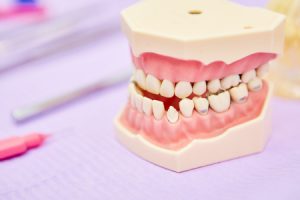
What Does It Mean?
When translated literally, malocclusion means “bad bite.” It refers to the way your teeth fit together when biting down or in a closed position.
In a proper bite, teeth fit together perfectly, like the pieces of a jigsaw puzzle. In the rear of your mouth, each tooth (molar, premolar, and bicuspid) nests against the opposing tooth with the ridges and grooves in sync. Meanwhile, in the front of the mouth, the canines and incisors don’t close directly against each other. Instead, the top teeth rest slightly forward, overlapping the lower teeth when the jaw is closed.
When it comes to malocclusion, there are several varieties, and each can have a negative impact on oral health and the function of your mouth.
Common Types of Malocclusion
Overcrowding is when there’s not enough space in the mouth, and teeth appear misaligned and overlap their neighbors.
Spacing is the opposite of overcrowding. There may be large gaps between teeth when there is too much room in the mouth.
An overjet describes how far forward the front top teeth rest in relation to the bottom front teeth. While a slight overjet of 2-3mm is considered normal, if top teeth protrude too far it’s called an excess overjet. (To the general public, an overjet is commonly mistakenly called an overbite.)
In actuality, an overbite is how far the top front teeth overlap vertically with the bottom. A normal overbite will obscure about 15% of the bottom teeth
An underbite is the opposite of an overjet, where the bottom teeth protrude in front of the top teeth.
An open bite is when the teeth don’t close together all the way. This is most common in the front of the mouth, but can also sometimes affect the rear teeth.
A crossbite is similar to an underbite, in which the top teeth fit inside the lower teeth when closed. It may affect just the front or rear teeth, a certain section of teeth, or even just a single tooth specifically.
What to do about it?
You may experience one or more types of malocclusion at once! The first step is to receive a bite assessment at the dentist’s office to determine the exact nature of your condition. With braces/aligners or other dental treatments, most malocclusions are relatively easy to address. After successful treatment, you may notice improved appearance to your smile and better functionality when eating and speaking.
